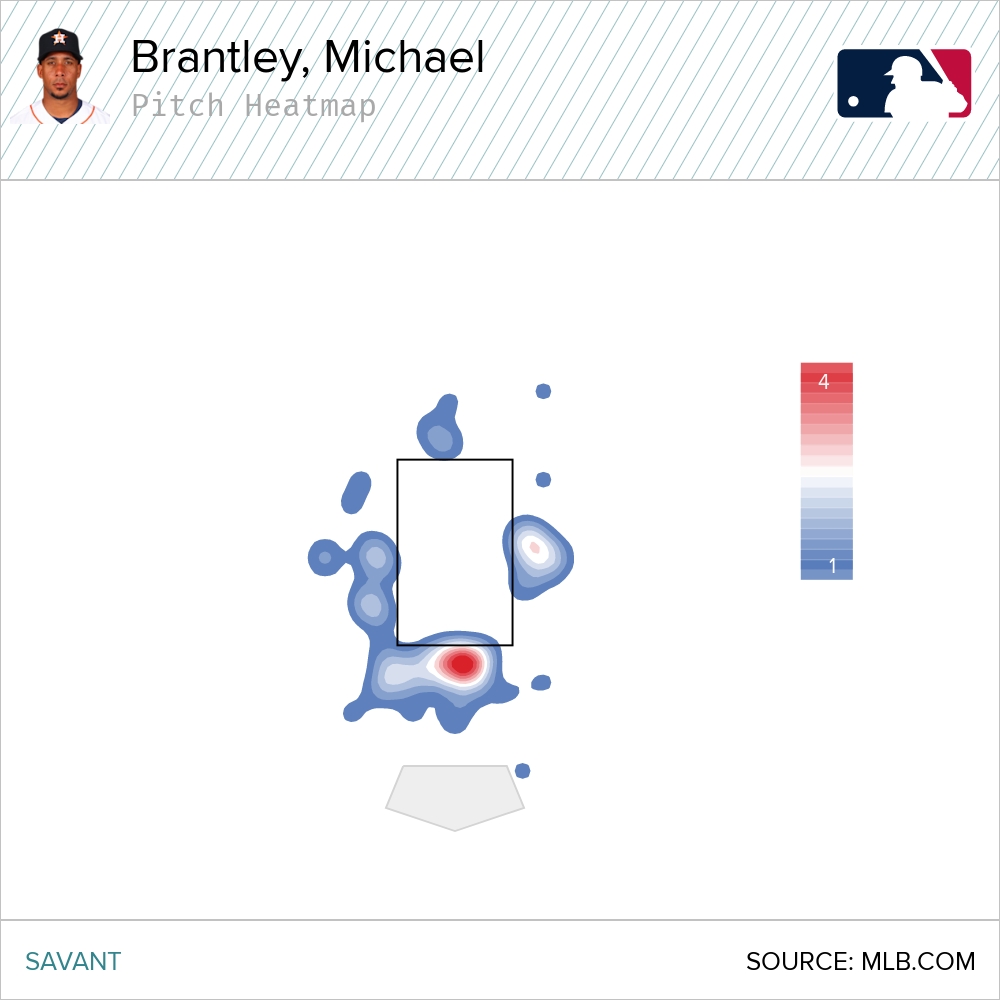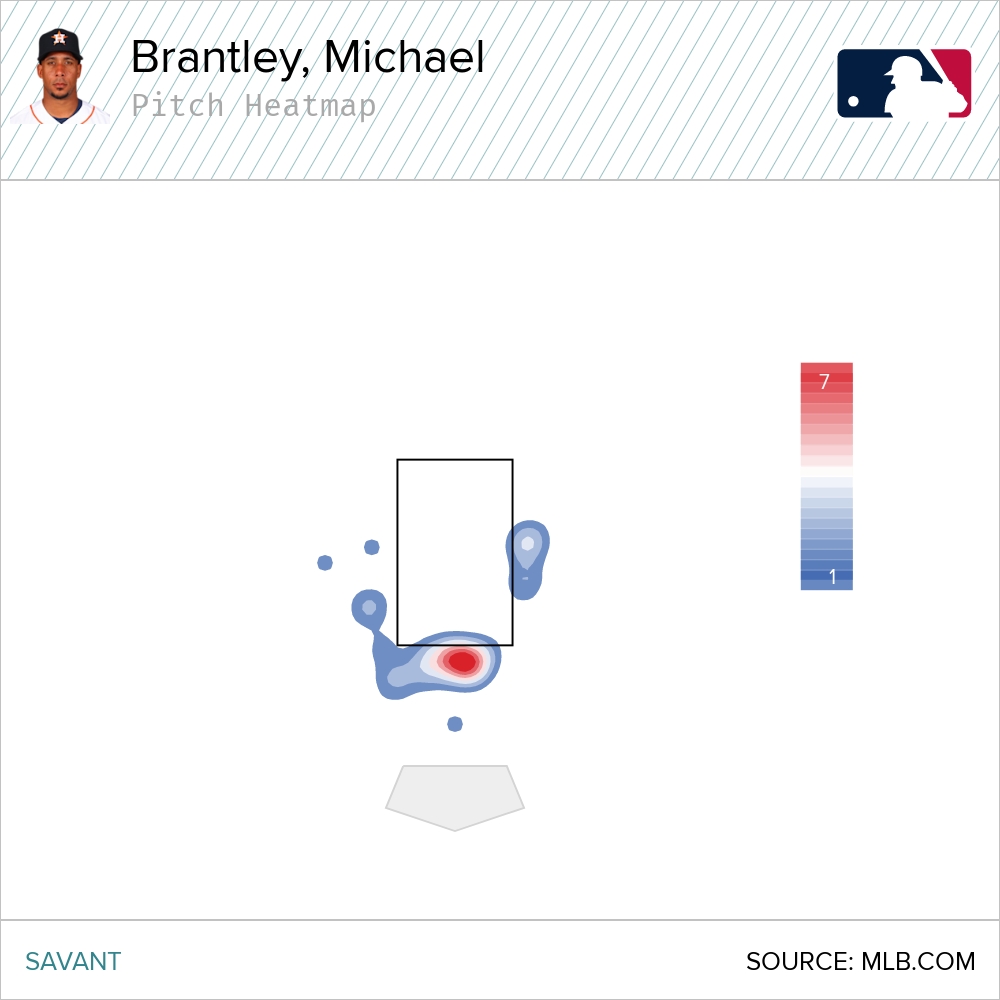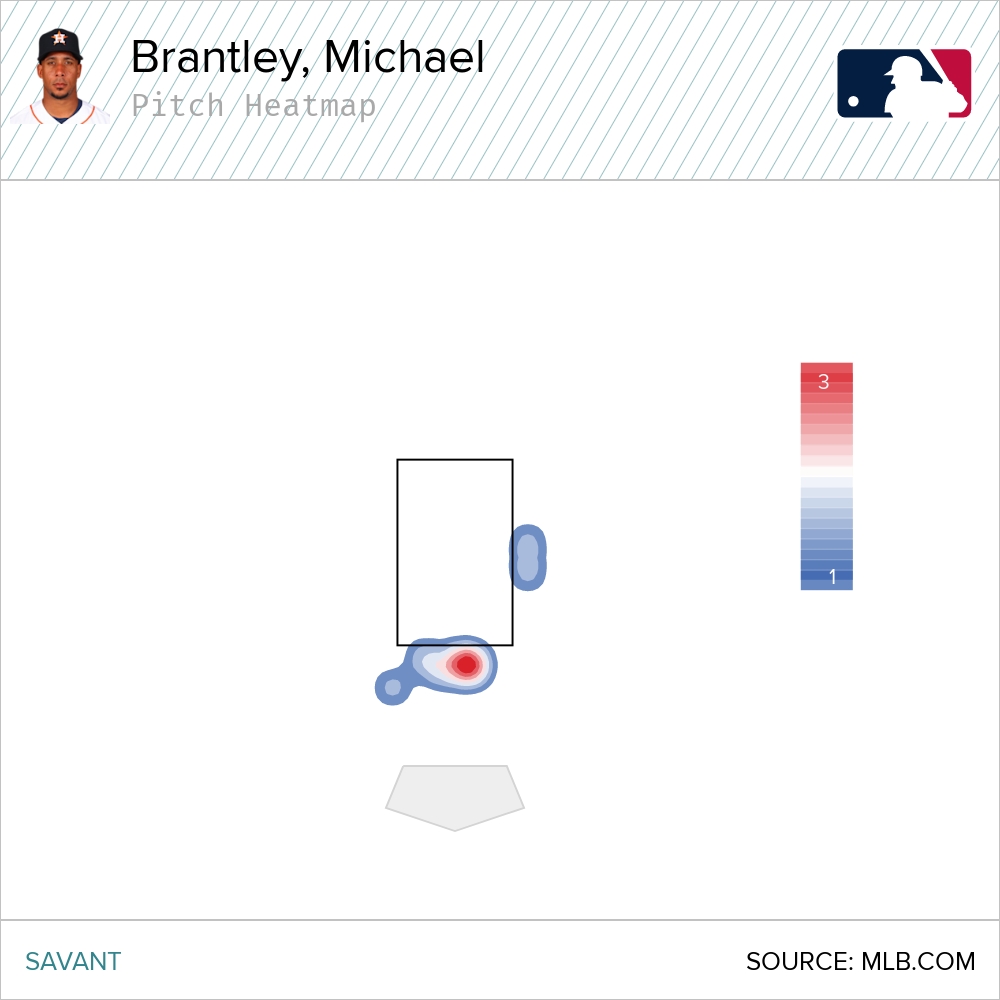There are a few things that always seem to happen each season and without them, it just wouldn’t quite feel right. One is Mike Trout being the best hitter in the game each season, or in recent years, Jacob deGrom and Gerrit Cole striking out the world. Another thing that just seems to happen each year is Michael Brantley ending up as one of the game’s better hitters.
He’s been super consistent throughout his career, and while he’ll turn 34-years-old next month, shows little sign of slowing down. Every year it seems like that decline and father time will get him, but so far, Brantley appears to have been able to delay that yet another year – through the early part of the season, Brantley looks as solid as ever. In fact, Brantley may even be better than ever before, as it looks like he’s doing some things differently at the plate this year.
Brantley’s baseline stats are impressive on their own –.330/.358/.527 – as he is maintaining his reputation as a high batting average hitter, while also showcasing some added pop and extra-base hit ability. His 155 wRC+ is one of the top-20 best in the game, while also keeping true to form with a top-20 strikeout rate, sitting at 13.7%.
When evaluating what’s different with Brantley this season and driving this excellent run of form, not much immediately stands out when looking at his Statcast profile. Comparing to the last few years, Brantley is barreling a few more balls, but he’s not killing the ball. His average exit velocity is identical to last year tick and his hard-hit rate is actually lower than it was last year:
| Season | Barrel % | AVG EV | Hard-Hit % |
|---|---|---|---|
| 2018 | 3.5 | 90.2 | 38.4 |
| 2019 | 5.5 | 88.8 | 37.3 |
| 2020 | 4.9 | 88.7 | 37.3 |
| 2021 | 6.3 | 88.7 | 33.8 |
That shouldn’t spell out doom and gloom for Brantley though. He’s never been the type of hitter that lights up those types of metrics, and while there are things that he’s doing differently, it shouldn’t be expected for him to suddenly start hitting the ball so much harder at this stage of his career.
Rather, what Brantley can do differently is change up his batted-ball mix. One thing that has limited Brantley’s power output throughout his career has been that he hits a few too many balls on the ground. He hasn’t hit grounders at such an alarming rate previously in his career, but he has hit fewer of them so far this season, which has led to his average launch angle is the highest it’s been for him the last few years:
| Season | GB % | AVG LA |
|---|---|---|
| 2018 | 46.2 | 9.5 |
| 2019 | 46.0 | 10.6 |
| 2020 | 47.9 | 10.2 |
| 2021 | 41.3 | 11.4 |
Hitting fewer groundballs is a plus for obvious reasons, and where it’s really made a difference for Brantley this season, in particular, is with his line-drive rate, as it seems like he has traded a lot of those grounders for the much more desirable line drives:
| Season | GB % | FB % | LD % |
|---|---|---|---|
| 2018 | 46.2 | 18.0 | 31.1 |
| 2019 | 46.0 | 20.9 | 28.1 |
| 2020 | 47.9 | 21.8 | 27.5 |
| 2021 | 41.3 | 17.5 | 37.5 |
Another way to look at it would be in terms of sweet-spot rate, which is simply the rate at which a batter’s batted balls are hit in the eight to 32-degree launch angle intervals, which are generally the most ideal place for a hitter to launch at – hence the name. Brantley has consistently been above-average in this department over the course of his career. However this year, Brantley has moved from above-average to elite, with one of the highest sweet-spot rates in the game to this point:
| Player | SwSpo % |
|---|---|
| Robbie Grossman | 50.0 |
| Aaron Judge | 47.6 |
| Michael Brantley | 47.5 |
| Ty France | 45.5 |
| Justin Turner | 44.9 |
Sweet-spot rate isn’t a perfect stat, as the quality of contact is left out of the equation, but it certainly is not a bad thing to be towards the top of this leaderboard, and generally, the hitters at the top so far this year are off to good starts. Essentially, this is just a fancier way of saying that Brantley is hitting the ball a lot more optimally. More line drives and more balls in the sweet spot usually equals good results. It’s shocking, I know. But, we can see that is the case for Brantley, as he is getting better results overall on line drives than he normally would in a full season:
| Season | AVG EV | wOBA | SLG |
|---|---|---|---|
| 2018 | 92.6 | 0.633 | 0.868 |
| 2019 | 91.1 | 0.591 | 0.824 |
| 2020 | 93.6 | 0.700 | 1.051 |
| 2021 | 95.1 | 0.753 | 1.100 |
And it’s a similar tune on batted-balls in the sweet spot:
| Season | AVG EV | wOBA | SLG |
|---|---|---|---|
| 2018 | 92.5 | 0.669 | 1.020 |
| 2019 | 92.2 | 0.649 | 1.036 |
| 2020 | 91.5 | 0.691 | 1.073 |
| 2021 | 93.8 | 0.706 | 1.053 |
That’s all well and good, but that’s not the only thing that’s different so far when it comes to Brantley this season.
This is where things get a little more fun, and it has to do with Brantley’s approach. The short of it is that Brantley is swinging more – a lot more. It’s quite the contrast from the type of hitter he’s been in his career, as he’s gone from being pretty passive at the plate to suddenly being a lot more aggressive:
| Season | Swing % |
|---|---|
| 2018 | 44.2 |
| 2019 | 43.8 |
| 2020 | 39.9 |
| 2021 | 49.6 |
For additional context, Brantley’s career swing rate is just 43.6%, and last season, his swing rate was just 39.9% – his lowest in the Statcast era, which shows just how big of a difference this shift in approach has been for him this year. That jump of nearly ten percent in swing rate this year is one of the largest among hitters so far this season:
| Player | Swing % 2021 | Swing % 2020 | Difference |
|---|---|---|---|
| Joey Votto | 47.2 | 36.2 | 11.0 |
| Carlos Santana | 46.8 | 36.3 | 10.5 |
| Michael Brantley | 49.6 | 39.9 | 9.7 |
| Kyle Seager | 49.2 | 40.3 | 8.9 |
| Willy Adames | 54.2 | 46.2 | 8.0 |
As it appears, Brantley isn’t the only veteran to suddenly start swinging more, as four of the top five names here are all veterans going from being among the game’s more selective hitters to suddenly more aggressive. Also notable for Brantley is that he is jumping on a lot more first pitches, going from a 20.9% first-pitch swing rate last year to 26.3% this year – a rate that is right in line with the league average. It definitely looks like Brantley has made a conscious effort to be more aggressive at the plate this year. It makes sense, as more swings combined with his excellent bat-to-ball skills give Brantley more opportunities to hit those line drives that he is now quite fond of, which has led to the better results he’s experienced so far this season.
Some of those extra swings are coming on pitches in the zone, as his zone swing rate of 66% is nearly seven percent higher than last year and would also be the highest single-season mark of his career, it’s not far off of his career 63.5% average. Rather, a lot of these extra swings have been on pitches out of the zone, as shown by chase rate:
| Season | Chase % |
|---|---|
| 2018 | 23.7 |
| 2019 | 26.0 |
| 2020 | 20.0 |
| 2021 | 32.8 |
That is an uncharacteristically high chase rate for a hitter like Brantley, who is usually one of the game’s best at avoiding pitches out of the zone. His chase rate this year is above-average – which again is surprising considering the type of hitter Brantley has been in his career.
Normally more chases would be a bad thing, as more chases can lead to more strikeouts, which are usually not how a hitter wants to end their at-bats. For Brantley this year, however, all of those extra swings haven’t led to more whiffs. It’s actually been the opposite, as Brantley has improved his whiff rate from last season’s career-high (although still very good) mark:
| Season | Whiff % |
|---|---|
| 2018 | 11.0 |
| 2019 | 10.7 |
| 2020 | 16.3 |
| 2021 | 9.5 |
Those extra swings have led to more contact on pitches in the zone, which is good for obvious reasons, but we also see that Brantley is making a much higher rate of contact on pitches out of the zone too:
| Season | Chase Contact % |
|---|---|
| 2018 | 71.0 |
| 2019 | 76.1 |
| 2020 | 64.8 |
| 2021 | 85.5 |
Brantley’s chase-contact rates have pretty much been better than average for his entire career, but this is a whole other level completely. His chase-contact rate is currently the third-highest in baseball, only behind two other contact specialists in David Fletcher and Nick Madrigal. So, Brantley is swinging more and making more contact, even on pitches that are supposed to be more difficult and less desirable for hitters to swing at, but is that actually a good thing?
While Brantley is being more aggressive at the plate when looking at the big picture, his success at making contact on pitches out of the zone may come back to his excellent selectivity. Hitters generally aren’t supposed to want to make contact on non-strikes, but when looking at the pitches out of the zone that Brantley has swung at this season, a lot of them look to be in one area in particular:

Those pitches in the red area are technically pitches out of the zone, but it looks like they aren’t so far off the plate, and can still be hittable pitches – especially for a hitter like Brantley that can make a lot of contact. That heatmap matches with where he is both making contact on pitches out of the zone:

As well as where he has gotten hits on pitches out of the zone:

The red areas match up nearly perfectly on each one. It seems that despite those being pitches out of the zone, Brantley realizes those are still pitches he can do damage to and doesn’t need to lay off them. After all, why take pitches that you can damage with? It looks like Brantley likes that pitch down in the zone, and even if it’s too low and slightly out of the strike zone, he can still hit it, and right now, he’s getting contact and base-hits when he does, as opposed to other hitters who might whiff on those pitches instead.
Overall, Brantley looks to be more aggressive at the plate this season, and with his good batted-ball metrics and excellent distribution, he’s off to quite the nice start this season. The extra aggressiveness is nice as it allows Brantley to better showcase his skills and ultimately be an even more productive player. Of course, this is still a small sample we’re talking about so some disclaimers need to be made. While the extra contact on pitches out of the zone isn’t too surprising considering the type of player Brantley is, it is hard to expect him to maintain that level over the course of a full season, as no one had that high of a chase-contact rate last year or in 2019. Even with that being the case though, the early returns on this new version of Brantley look good. There’s no doubting that Brantley is one of the game’s best pure hitters, and making the adjustment to being more aggressive has showcased that ability even more so.
Photo by Brian Rothmuller/Icon Sportswire | Adapted by Doug Carlin (@Bdougals on Twitter)

